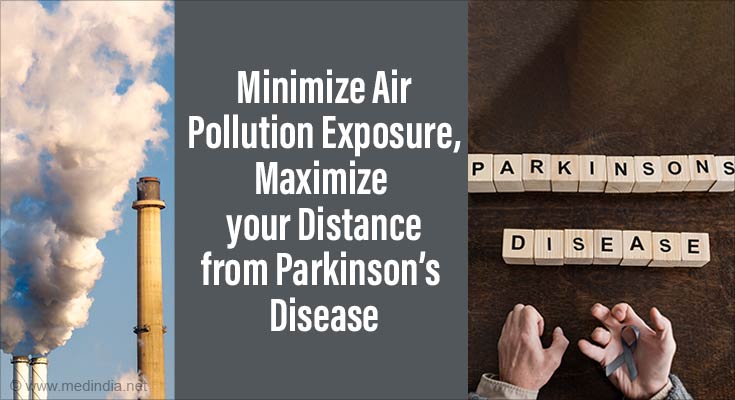, the biggest environmental health risk in the world, has been linked to PD risk. The main air pollution risk factors that affect Parkinson’s disease (PD) depend on the kind of pollutants, the duration of exposure, and the geospatial exposure levels.
The main gaseous pollutants found in outdoor air are ozone (O3), sulfur dioxide (SO2), nitrogen dioxide (NO2), carbon monoxide (CO), and nitrous oxide (NO). These pollutants can originate from natural sources like forest and grass fires and also from anthropogenic sources like power plants, vehicles, trucks, buses, and burning fuels including coal, wood, and heating oil.
Research indicates that extended exposure to NO2, NOx, CO, and O3 is linked to a higher risk of Parkinson’s disease (PD) (1✔ ✔Trusted Source
Association between ambient air pollution and Parkinson’s disease: Systematic review and meta-analysis
Go to source
). Specifically, NO2 exposure is related to a statistically significant increase in PD risk during a 5-year period (3✔ ✔Trusted Source
Association of NO2 and Other Air Pollution Exposures With the Risk of Parkinson Disease
Go to source
).
Advertisement
The air we breathe is also contaminated by particulate matter (PM), which is made up of microscopic particles and liquid droplets.
A micron is one-millionth of a meter, and PM can have sizes between 0.01 and 300 microns. “Inhalable particles”particulates smaller than 10 micronscan penetrate deeply into our lungs and possibly into the bloodstream. Even tiny particles2.5 millimeters or lesspresent a higher risk since they can readily enter the lungs and in turn into the blood circulation (2✔ ✔Trusted Source
PD & Pollution: Something in the Air
Go to source).
Research reveals that long-term exposure to PM2.5 at levels far higher than the recommended thresholds may raise the risk of Parkinson’s disease (5✔ ✔Trusted Source
Long-term effects of PM2·5 on neurological disorders in the American Medicare population: a longitudinal cohort study
Go to source).
Environmental exposures play a critical role in Parkinson’s disease (PD) pathogenesis. Living in areas with the highest median levels of air pollution puts residents at a 56 percent higher risk of Parkinson’s disease than residents in areas with the lowest levels of pollution, reveals a study (4✔ ✔Trusted Source
Fine Particulate Matter and Parkinson Disease Risk Among Medicare Beneficiaries
Go to source).
What is the Underlying Mechanism of Air Pollution Inducing Parkinson’s Disease?
Four mechanisms were found by researchers to explain how air pollution can raise the chance of developing Parkinson’s disease:
-
Neuroinflammation and Neurotoxicity:
Particulates from air pollution are breathed through the nose and enter the bloodstream or lungs. Air pollution can be neurotoxic, or poisonous to the nervous system, once it enters the brain. This can lead to neuroinflammation, which can increase the buildup of alpha-synuclein, a protein that is important in Parkinson’s disease, and reduce the number of dopaminergic neurons, which are the two classic symptoms of Parkinson’s disease pathology
-
The Air Pollution-Lung-Brain Link:
Air pollution exposure can lead to lung and airway inflammation, which can then result in brain inflammation. This may eventually cause damage to brain cells and could be even fatal
-
Air pollution and Gut Connection:
Air pollution induces inflammation in the gut and localized alpha-synuclein accumulation (clumping). These aberrant alpha-synucleins spreading from the gut through the vagus nerve into the brain, causes dopamine loss and further brain damage
-
The Gut Microbiome-Brain Link:
Billions of bacteria, fungi, and viruses reside in our gastrointestinal tracts known as the gut microbiome, can be altered by air pollution. This changed state of the gut results in brain inflammation. It is still unclear if changed microbiota can actually influence the development of Parkinson’s disease (PD), despite studies showing indications of it in patients with the disease
Way Forward
It’s always a healthy idea to limit your exposure to outdoor air pollution wherever possible, even though most of us have no control over the air we breathe on a daily basis. In the meanwhile, comprehensive health policies and tougher regulations to reduce air pollution levels should be taken into consideration, particularly for targeted and vulnerable people.
References :
- Association between ambient air pollution and Parkinson’s disease: Systematic review and meta-analysis – (https://pubmed.ncbi.nlm.nih.gov/30391837/)
- PD & Pollution: Something in the Air – (https://www.parkinson.org/blog/science-news/air-pollution)
- Association of NO2 and Other Air Pollution Exposures With the Risk of Parkinson Disease – (https://jamanetwork.com/journals/jamaneurology/fullarticle/2780249)
- Fine Particulate Matter and Parkinson Disease Risk Among Medicare Beneficiaries – (https://n.neurology.org/content/early/2023/10/26/WNL.0000000000207871)
- Long-term effects of PM2·5 on neurological disorders in the American Medicare population: a longitudinal cohort study – (https://www.ncbi.nlm.nih.gov/pmc/articles/PMC7720425/)
Source: Medindia



